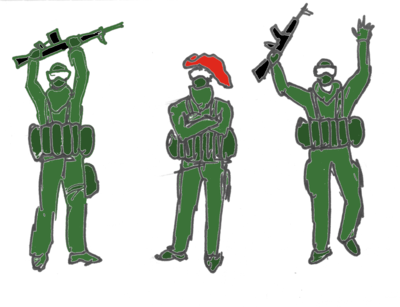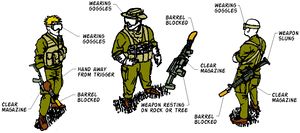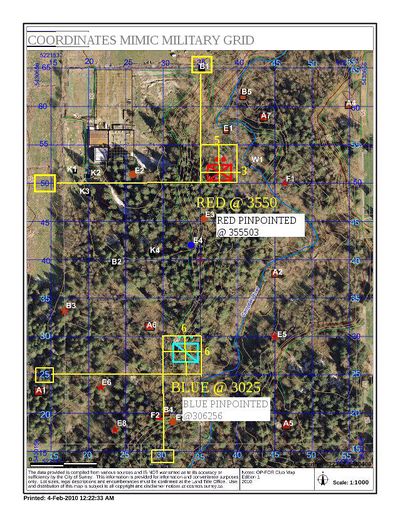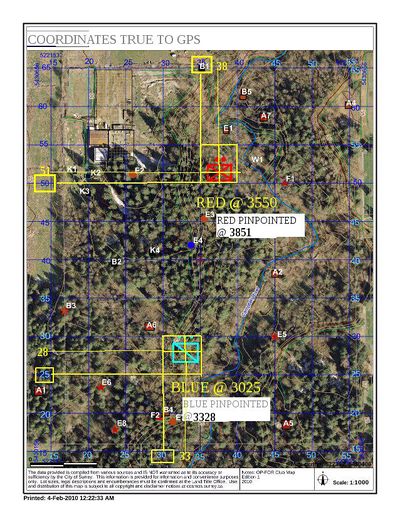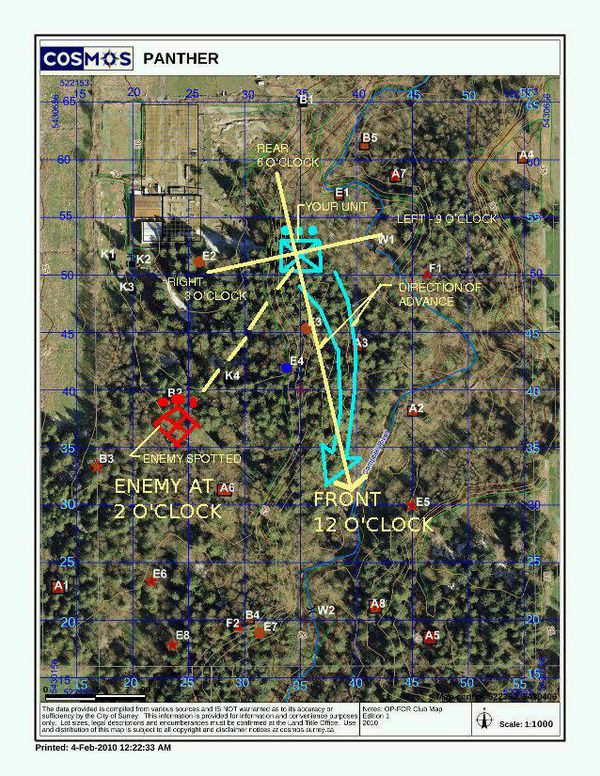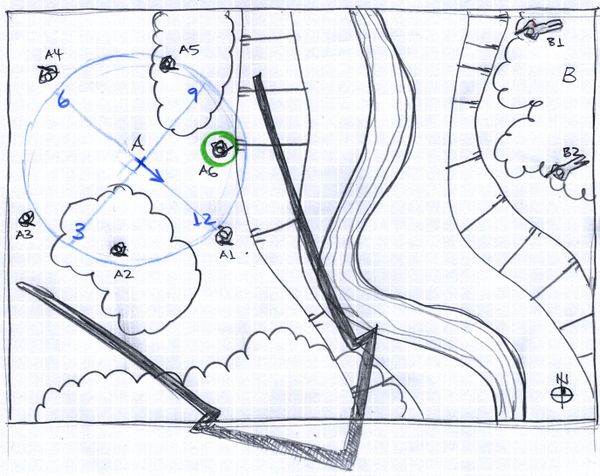Difference between revisions of "Tactical and Safety Field Guide"
| Line 133: | Line 133: | ||
Communication throughout a team is not only important, but essential. Sharing information within your team is the key to victory. Whether it may be through radio transmissions, hand signals, verbal dialogue, or otherwise, communication is key to a team's survival on the field. Make sure that you relay any information on enemy positions, remaining enemies, eliminated enemies, or any other information that may be of value to your teammates. | Communication throughout a team is not only important, but essential. Sharing information within your team is the key to victory. Whether it may be through radio transmissions, hand signals, verbal dialogue, or otherwise, communication is key to a team's survival on the field. Make sure that you relay any information on enemy positions, remaining enemies, eliminated enemies, or any other information that may be of value to your teammates. | ||
| − | Radios can ease communications when good | + | Radios can ease communications when good [[ Radio Protocol ]] and discipline are used. |
=== Patrolling === | === Patrolling === | ||
Revision as of 03:47, 10 February 2013
Contents
General (Individual, Buddy, Team)
Originally posted by Savage Haggis on Sun, 07 Feb 2010 / 00:18. This post is based on an entertaining and detailed version available at http://300club.net/filepile/How%20to%20Not%20be%20Useless%20when%20Playing%20Soldier.pdf (includes pictures)
Fundamentals
Automatically and always (details follow):
- cross behind other players
- look for and call out enemies (contact reports)
- move so you won't be seen ("I'm up. He sees me. I'm down.")
- shoot so you won't be seen
- follow your leader
- coordinate with and trust your squadmates to cover slices of the 360 degrees around your team
- know your squad's task within the mission
- be aware of team-related responsibilities (see below)
Basics
Minimum knowledge:
- know the rough geography of your area (landmarks, directions, and so on)
- understand clock directions and at least that the 12 o'clock is the way to your objective
- you must flank an enemy to destroy them (send a second group to attack their side or rear)
- keep the enemy busy until the flanking group has destroyed them
Contact Reporting
After you see an enemy, tell your squad:
- most important thing to do
- Format: "Contact", direction, identity, distance or landmark
- Example: "Contact northwest. Sniper top of tower."
- remember that some contacts can be left alone and monitored[/list]
Moving to Survive
Especially important:
- Surviving with your team to win your objective is better than killing some random guy through a bunkered-down shootout
- plan ahead your next stop
- move from cover to cover or concealment to concealment
- move in a series of small rushes if you are under fire
- notice all the cover available around you
- concealment includes shadows, brush, objects, depressions, crawling, lying prone
- kneel onto one knee whenever you stop for more than 2 seconds
- lay down or hide whenever you stop for more than 2 minutes
- avoid silhouetting yourself against sky or a contrasting background
- move along ridges 1/3 of the way down the bank
- spread out a little (make it harder for someone to shoot you all at once)
Buddy Teams Improve Your Effectiveness
- smallest combat unit (two players)
- buddies watch out for each other
- stay together (but spread out a little if possible)
Fire Teams Generate Success
- two or three buddy teams together
- fundamental combat unit (usually referred to as a squad in games)
- leader and special roles must be in separate buddy teams
- fire-team leader stays in touch with overall team leader (additional radio or periodic check-ins on overall team radio channel
- smallest unit with separate radio channel is a fire team
Working as Buddies
Automatically and constantly:
- Stick with your buddy: you are more effective together, so you should stay close to them when they move
- Communicate with your buddy: if you plan to move, if you see something, if you need to reload. You should both know the same stuff
- Cover your buddy: if they watch one way, watch the other way; if they cross a danger area, watch for enemies that could shoot them and respond accordingly
- Help your buddy directly or make it easier for others to help your buddy
- Return to your buddy: if you die and respawn, it is your responsibility to hook back up with your buddy; if your buddy is dead, you join the rest of the fireteam until your buddy rejoins you
Covering
- from behind cover or concealment
- keep your weapon ready and your eyes peeled, ready to shoot any enemy that shows up while your buddy moves, medics, or whatever else
- under fire, cover by shooting at the enemy; make them duck down, stop shooting and take cover
Working in a Fire-Team
- Know your FireTeam: who they all are and who leads (follow their lead)
- Know your FireTeam's mission: what your fireteam needs to do for the overall team
- Practice fire and noise discipline: unneeded sound alerts your enemies
- Maintain "situational" awareness: where are your friends? where are your targets? watch for flankers! keep spread out!
- Cover your sector: 360-degree security means that everyone in the fireteam needs to cover a different piece of the surrounding landscape and ensuring that all sides are watched
- Communicate promptly: share any new enemy targets with the team leader before you shoot
- Communicate effectively: be brief and concise, always striving for barest format
- Move using overwatch, including "bounding overwatch" [look it up]
- Maintain a working radio
- Talk on the radio in few words using club radio protocol
Example
A member of Fireteam Alpha encounters an enemy squad (notice the contact report, although you probably will not use a compass heading as the direction). They start shooting at each other, and Alpha's leader talks to Bravo's leader on the command channel to let them know what's happening and asks if Bravo can help (by flanking the enemy.)
Bravo's Fireteam Leader agrees and lets Alpha know that Bravo will be coming in from the southwest – so Alpha knows not to shoot at them. While the enemy is being a bunch of bunker noobs, Bravo flanks them and wipes them out from the side or rear in a surprise assault.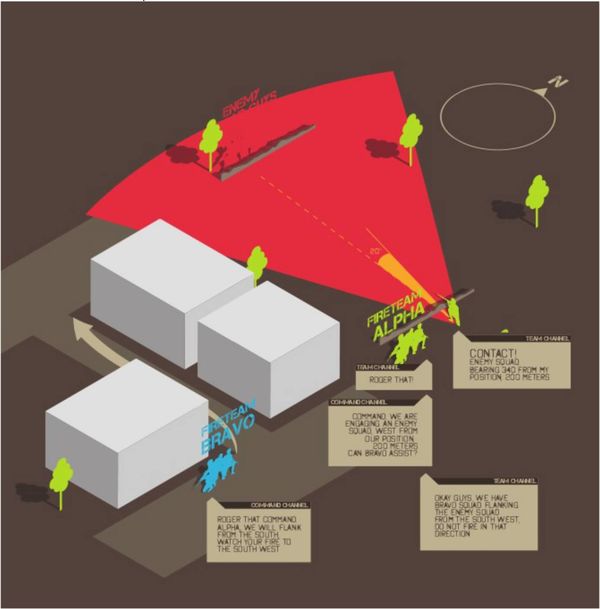
Tips
Originally posted by Savage Haggis on Wed, 06 May 2009 / 11:02. This post is based on information originally posted by SarViet in the Illinois Airsoft Forums as well as WALK_ON, Obsidian, Dragon, jackal69, Nanashiroff, and Chris Clark in the Texas Airsoft Organization forums
General Pointers from Players
- game is as much mental skill as it is physical skill
- remember your patience; the most patient almost always get first shot
- be aware of your friends and foes
- be aware of everything you can conceivably be aware of: wind, smell, noise, shapes (Anything and everything on any field will either kill you or keep you alive)
- keep moving, someone will flank you and shoot you
- take your time and make a good shot count -- good shots don't come along very often, and you find them by moving around your enemy's cover
- your enemy will try to move if they think you are gaining better position, leaving themselves open
- avoid making predictable movements
- If possible, watch your enemy's head when you're in a fire-fight, chances are he will give away his movement to his next object of cover by looking in that general direction (Proceed to aim there, when he gets there, shoot him)
- You're not going to walk into the perfect situation. You have to make it happen. If you do walk into a perfect situation, chances are it's not and you're gonna get shot
- if you can't see your opponent, move
- Keep your head down
- You are never safe so don't think you are
- Never underestimate the bad guys
- Reload whenever you get the chance (and wind your hi-caps often)
- Don't shoot till you know you can hit them
- If the bad guy knows where you are, don't be there when he starts shooting
- Cover and concealment are 2 different things...dont mix them up
- If you can't ID friend of foe and they don't respond....shoot them
- Make sure your gun works at the start of the game
- When all else fails...rush them. It has the element of surprise.
- If they're in range, keep shooting till you hear them yell "HIT"
- When someone makes a buffalo charge get ready to shoot in that area because they will probably move
Minimize Your Exposure
- Use Obstacles Well: Look around the side of an obstacle to minimize your exposure as a target
- Stay Down: lowering yourself improves your concealment (remember to keep your airsoft gun out of the water or mud when low to the ground)
- Noise Discipline: Quiet = stealth (Tape down any & all loose or noisy, or potentially noisy items on yourself, your gear & your weapon -- LBV clips, straps, sling mounts, etc)
- Move only when you must: Unnecessary or sudden movement attracts the eye (and direct fire!)
- Plan your next location before moving: Being stealthy means not being detected, allowing you to surprise your enemy
- Always have your escape thought out: When advancing upon, or trying to gather info about the enemy, your success depends on upon getting out of trouble just as quickly as you got into it
- Quick Glances: peek quickly because your enemy may have seen you and the longer you look the longer you are vulnerable
3 to 5 Second Buddy Rushes
When assaulting an airsoft objective with a teammate, use the buddy rush method. You may need to practice this a few times before the skirmish to get it right. You and your teammate alternate rushes for 3-5 seconds towards the target, while one of you puts suppressive fire on the objective. Utilize cover and concealment along the attack route, ensuring your rush ends at a spot that will protect you from enemy fire (a tree, log, rock, etc). Use hand signals to indicate when you are ready to move or lay down suppressive fire. Your stream of airsoft ammo will keep you opponent down while your buddy moves forward.
Fool your opponent
If an airsoft player continues to shoot at an enemy, it usually means that they have a good angle on their target. If someone is shooting at you continuously, you need to change position as soon as possible. However, if you have a good position on your opponent, you may want to consider hesitating with your shots, making them think that they're safe. This can draw them out in the open making them an easy target. This is a time tested airsoft tactic.
Covering Fire
One of the best and most commonly used tactics in airsoft is cover fire. This involves sending a hail of bbs in the general direction of the enemy to allow movement for your teammates. This tactic works extremely well because of one thing; if bbs started hitting all around you, your natural instinct is to stay low until the suppresive fire produced by the enemy stops.
Communication
Communication throughout a team is not only important, but essential. Sharing information within your team is the key to victory. Whether it may be through radio transmissions, hand signals, verbal dialogue, or otherwise, communication is key to a team's survival on the field. Make sure that you relay any information on enemy positions, remaining enemies, eliminated enemies, or any other information that may be of value to your teammates.
Radios can ease communications when good Radio Protocol and discipline are used.
Patrolling
When patrolling, the devil is in the details. Little things can give away the position of your enemies with ease. If you see an animal running away, chances are it was frightened by large, lumbering men wielding guns, thus you should immediately be on your guard. Don't over-interpret various natural signs, but if you see something that blatantly signifies the presence of an enemy, be on the lookout.
Safety Procedures
The information in this post is taken from the Rule Book
Identifying Out-of-Play Players
"Dead" players (INVALID TARGETS) look like this:
- They are prohibited from providing any game information to their team or interacting with game props or other game items.
- Dead players must not shoot unless they want to appear as valid targets to the other players.
- Good players strive to avoid shooting dead players, it's a waste of effort.
- Also, give players a chance to reveal whether they are dead, shoot in bursts and give your shots time to hit them before shooting again. The action of your AEG may mask a player's hit call, so give them time between bursts-- count to 3 or 5 before shooting again, for example.
Gun Safe Procedure
When a Field Marshal or Admin calls for a Gun Safe, this is what it looks like:
Shooting stops, players get into the position shown above.
When players do this, the admins can address the safety issue. Once resolved, the marshals and admins will call for play to resume. Gun Safe stays in effect until marshals say it's over.
Consequence of violating this safety rule: suspension for the rest of the DAY. Violate it three times and you could be banned for a few months.
The above image shows the best possible response to the Gun Safe. Remember:
- Mag out!
- Condom on!
- Goggles on!
- Gun out of hand (Ok, Ok. Drop it to your sling, just reduce your temptation to shoot)
Maps and Directions
Originally Posted Tue, 03 May 2011 / 23:57 by jsae
- Using Grid References on the club map
- Some Military Map Symbols
- Using clock directions
Using Grid References at Panther
Three ways to use the map for indicating location, Enemy in Red
Areas of Operation
- using the Noob Map: media:Panther-newb.jpg
Spearhead this is Sparrow. Enemy northeast of Pole to Pole. Over
Mimic Military Grid Reference System
- recommended
- "MGRS exact" level of detail: 6 digits
Spearhead this is Sparrow. Enemy at 355503. Over
- "MGRS approx" level of detail: 4 digits
Spearhead this is Sparrow. Enemy at 3550. Over
- MGRS Example - each square is 10x10 m, each unit is 5m box (numbered 0-9 across the side of the grid square)
Abbreviated GPS UTM
- easy with handheld GPS set to UTM
Spearhead this is Sparrow. Enemy at 3851. Over
- GPS Example - each square is 5x5 m, each unit is 10m box
Reading coordinates: "In the door and up the stairs"
From A-CR-CCP-121/PT-001, EO 405.03: LOCATE SPECIFIC POINT ON A MAP USING A FOUR AND SIX FIGURE GRID REFERENCE AND CONSTRUCTING A ROMER. Substitute 50m grid squares for our game use.
Military grid references use the two-digit grid line numbers to identify specific grid squares. For centuries, mathematicians have always stated the X coordinate (horizontal) before the Y coordinate (vertical), so map users have adopted that procedure. Eastings are stated before Northings. Every 1000m grid square is identified by listing the numbers of the grid lines that intersect at its bottom left corner.
(example SNIPPED) Remember: a four-figure grid reference refers to the entire grid square. The easiest way to remember to list the eastings then northings is to say, “In the door, then up the stairs.”
(emphasis added)
Using Clock Directions
Originally posted Sat, 09 Apr 2011 / 20:42 by jsae
Everyone is familiar with the clock directions, right? So the following image shows how we pull them together to work as a team.
12 o'clock is always best established around a group. Usually easiest when travelling as it's your planned general direction. If you are stationary, it's also pretty easy: pick an object you can see and call it your 12 o'clock. Bingo, everyone has the same clock now. It's bigger than your personal one, and that helps since you are part of a unit, rather than just one vehicle (often seen as a plane in our favourite movies).
Once your unit shares the same directions, everyone shares the same direction to look when you see something.
For example, your unit is moving south-southeast and a team member spots an enemy unit to the right.
Since you are moving south-southwest, that's your 12. If the enemy is positioned as shown on the map below, What clock position are they when you are at the location shown?
Exactly. 2 o'clock, kind of forward right.
When you keep your movement discipline, if your right flank says "2 o'clock", then the leader in the middle just looks to the right front. This saves trying to figure out where the spotter is and their direction.
Avoid "my" anything in small unit tactics. Use your unit position as the centre and a shared known direction as your 12, and you will save precious time.
Originally Posted Sat, 10 Sep 2011 / 23:22 by jsae
Here's a tighter view of the squad clock in action.
Referring to the image below, a 6-man element is passing a two-man element near a river. The 6-man element (Alfa) is patrolling in a wedge with a drag man checking their rear. The two man element (Bravo) is monitoring activity approaching their encampment east of this close-up map.
Alfa-6 thinks he notices Bravo-2. A6 is highlighted by a green circle.
Using the unit direction clock, B2 is at the unit's 10 o'clock.
Alfa-6: "Contact 50 feet, 10 o'clock. "
The squad can react together to address the situation.
Challenge and Response - Identifying Your Targets using Passwords in the Field
Originally posted Sun, 25 Sep 2011 / 21:58 by jsae
Three ways to discover the affiliation of an armed group you encounter:
- Ask (less effective)
- Quick Challenge and Response
- Formal Challenge and Response[/list]
Ask
Two fireteams approach each other.
YOUR FIRETEAM
Which team are you on?
THEIR FIRETEAM
Which team are you on?
The fireteams continue to advance.
YOUR FIRETEAM
Which team are you on?
THEIR FIRETEAM
Which team are you on?
At 20 feet, the teams stop.
YOUR FIRETEAM
Which team are you on?
THEIR FIRETEAM
Which team are you on?
Challenge Password - Quick
Two fireteams approach each other. Continue to make sure you stay in cover, but get close enough you won't reveal the code to nearby enemies.
YOUR FIRETEAM LEADER
Top.
THEIR FIRETEAM LEADER
Hat.
Allow them to pass, they are friendly.
Challenge Response combination was: Top Hat.
Challenge Password - Formal
http://www.hardscrabblefarm.com/vn/passwords.html
Two fireteams approach each other. YOUR SENTRY OR SPOTTER
<bBockquote>Halt.
They stop.
YOUR SPOTTER
Who is there?
THEIR FIRETEAM LEADER
Squad Alfa.
Keeping hidden, bring them to 10 feet away and stop them.
YOUR SPOTTER
Advance and be recognized. ... Stop.
YOUR SPOTTER (Low clear voice.)
Top.
THEIR FIRETEAM LEADER (Low clear voice.)
Hat.
Allow them to pass, they are friendly.
Challenge Response combination was: Top Hat.
Can you think of and use other ways?
- Click codes (clicking your tongue a set number of times)
- Bird calls
